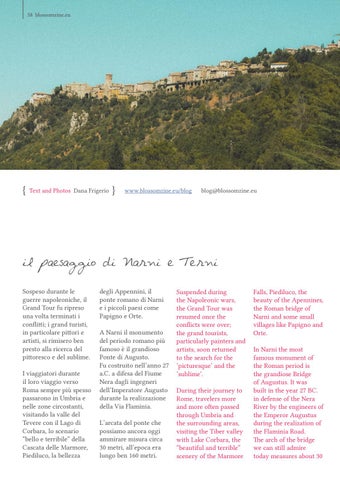58 blossomzine.eu
{
Text and Photos Dana Frigerio
}
www.blossomzine.eu/blog
blog@blossomzine.eu
il paesaggio di Narni e Terni Sospeso durante le guerre napoleoniche, il Grand Tour fu ripreso una volta terminati i conflitti; i grand turisti, in particolare pittori e artisti, si rimisero ben presto alla ricerca del pittoresco e del sublime. I viaggiatori durante il loro viaggio verso Roma sempre più spesso passarono in Umbria e nelle zone circostanti, visitando la valle del Tevere con il Lago di Corbara, lo scenario “bello e terribile” della Cascata delle Marmore, Piediluco, la bellezza
degli Appennini, il ponte romano di Narni e i piccoli paesi come Papigno e Orte. A Narni il monumento del periodo romano più famoso è il grandioso Ponte di Augusto. Fu costruito nell’anno 27 a.C. a difesa del Fiume Nera dagli ingegneri dell’Imperatore Augusto durante la realizzazione della Via Flaminia. L’arcata del ponte che possiamo ancora oggi ammirare misura circa 30 metri, all’epoca era lungo ben 160 metri.
Suspended during the Napoleonic wars, the Grand Tour was resumed once the conflicts were over; the grand tourists, particularly painters and artists, soon returned to the search for the ‘picturesque’ and the ‘sublime’. During their journey to Rome, travelers more and more often passed through Umbria and the surrounding areas, visiting the Tiber valley with Lake Corbara, the “beautiful and terrible” scenery of the Marmore
Falls, Piediluco, the beauty of the Apennines, the Roman bridge of Narni and some small villages like Papigno and Orte. In Narni the most famous monument of the Roman period is the grandiose Bridge of Augustus. It was built in the year 27 BC. in defense of the Nera River by the engineers of the Emperor Augustus during the realization of the Flaminia Road. The arch of the bridge we can still admire today measures about 30




